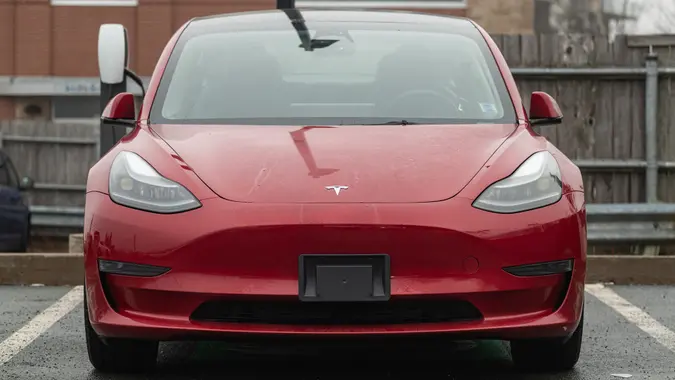How Middle-Class Families Are Handling Rising Costs

Commitment to Our Readers
GOBankingRates' editorial team is committed to bringing you unbiased reviews and information. We use data-driven methodologies to evaluate financial products and services - our reviews and ratings are not influenced by advertisers. You can read more about our editorial guidelines and our products and services review methodology.

20 Years
Helping You Live Richer

Reviewed
by Experts

Trusted by
Millions of Readers
Middle-class incomes used to provide a comfortable lifestyle. Sticking to a budget could allow families to buy a home, provide three nutritious meals daily — for all household members — and even enjoy occasional indulgences.
Check Out: Pocket an Extra $403 Per Month With This Simple Hack
However, things have changed. Middle-class families have been hit hard by inflation, making it difficult for many to keep their finances afloat.
As of 2021, half of U.S. households were considered middle class, according to the Pew Research Center. On a clear decline, this marks an 11% drop from 1971, when 61% of U.S. households identified as middle class.
Middle-class incomes have risen by a notable percentage over the past five decades, but it’s still not enough. The median income of middle-class households in 2020 — $90,131 — was about 50% greater than in 1970 — $59,934 — according to Pew.
The COVID-19 pandemic caused inflation to surge, drastically increasing the cost of living. Inflation is now on the decline, but the cost of living is still much higher than even a few years ago, which is causing a major budget crunch for many.
Here’s a look at how middle-class families are handling the increased cost of living, without having wage increases to match.
Food
Annual food at home prices in the U.S. were 5% more in 2023 than in 2022, according to the U.S. Department of Agriculture. Even more shocking, U.S. food prices surged 25% from 2019 to 2023.
As of October 2023, the average American household spent more than $1,000 per month — $270.21 per week — on groceries, according to a study by HelpAdvisor, using data analyzed from the U.S. Census Bureau Household Pulse Survey. This number increased to an average of $331.94 per week — more than $1,300 per month — for households with children.
Given these numbers, it isn’t surprising that many middle-class parents are having trouble keeping up with rising food costs. More than half — 58% — of middle-income families have found it harder to afford enough food for their children over the past year, according to a 2023 No Kid Hungry survey.
Sadly, 1 in 5 of these middle-income families revealed they or their children have skipped a meal in the past year due to increased food prices.
Even middle-class parents who have been able to provide three meals a day for their children are still concerned about the quality of the food they’re providing. More than three-quarters — 79% — worry about the nutritional value of at least one meal their children eat on a daily basis, according to the survey.
Housing
As of January 2024, the average sale price of houses sold in the U.S. was $492,300, according to the Federal Reserve Bank of St. Louis. Paired with a 6.9% average 30-year fixed-rate mortgage as of Feb. 22, this makes homeownership nothing more than a dream for many middle-class families.
“In the past, if you were middle class, it was almost assumed you would become a homeowner,” said Ali Wolf, chief economist of building consultancy Zonda, in a January 2024 report published by Realtor.com. “Today, the aspiration is still there, but it is a lot more difficult. You have to be wealthy or lucky.”
Two-thirds of Americans agree that homeownership isn’t a reality for middle-class buyers. Based on a median sales price of nearly $388,000, per the National Association of Realtors, 66% of people believe housing prices are too expensive for the middle class right now, according to a January 2024 Newsweek poll.
Unfortunately, this doesn’t mean renting is any more affordable. As of 2022, a record-high 22.4 million renter households spent more than 30% of their income on rent and utilities, according to a report from the Joint Center for Housing Studies of Harvard University. Even more substantial, 12.1 million households spent more than 50% of their income on rent and utilities.
Thankfully, there may be some relief for renters. The nationwide median rent fell by 0.3% to $1,373, according to the February 2024 Apartment List National Rent Report.
Of course, rent prices vary greatly by location. For example, according to Apartment List, the median rent is $953 per month in Cleveland and $2,061 per month in Los Angeles.
Savings
Since many middle-class families are struggling to keep up with basic living expenses, it isn’t surprising that saving money often isn’t possible right now. However, many people do at least have some money set aside for emergencies.
Specifically, 73% of middle-class people are currently having trouble saving for their future, according to a survey from Primerica. On a more positive note, 60% of people have at least $1,000 in an emergency fund.
What’s Next for the Middle Class?
Being part of the middle class once offered a sense of financial stability, but things have changed. These days, many middle-class families are struggling to afford even basic necessities.
Thankfully, change might be on the horizon. Nearly three-quarters — 70% — of middle-income consumers felt they were on the right track toward achieving financial prosperity, according to a Santander survey conducted in the fourth quarter of 2023.
However, two-thirds think the U.S. will enter a recession in 2024. This belief is so strong that 57% have delayed a major financial decision because of it.
Economists don’t necessarily share this sentiment.
In fact, only a quarter of National Association for Business Economics members who responded to the February 2024 NABE Economic Policy Survey believe a recession will happen in 2024, according to Ellen Zentner, NABE president, chief U.S. economist and managing director, Morgan Stanley. However, 22% believe a recession will happen in 2025, and 36% predict one will occur in 2026 or later.
Only time will tell what’s next for middle-class families. Hopefully, some much-needed economic relief will be found in 2024.
Data is accurate as of Feb. 28, 2024, and is subject to change.
Our in-house research team and on-site financial experts work together to create content that’s accurate, impartial, and up to date. We fact-check every single statistic, quote and fact using trusted primary resources to make sure the information we provide is correct. You can learn more about GOBankingRates’ processes and standards in our editorial policy.
- U.S. Department of Agriculture. 2024. "Food Prices and Spending."
- Joint Center for Housing Studies of Harvard University. 2024. "America's Rental Housing 2024."
- Santander US. 2024. "Santander US Middle-Income Survey Finds Majority of Americans Remained Optimistic in 2023, See Headwinds Ahead in 2024."
- National Association for Business Economics. 2024. "Economic Policy Survey."
- Bureau of Labor Statistics. 2023. "What caused inflation to spike after 2020?"
- No Kid Hungry. 2023. "New National Poll: Parents Surveyed with Middle Incomes Among Those Struggling to Feed Families."
- Realtor.com. 2024. "A Reality Check for the American Dream: Who Can Afford a Home Right Now?"
- Newsweek. 2024. "Americans Don't Believe Middle Class Can Afford Homes."
 Written by
Written by  Edited by
Edited by 

























